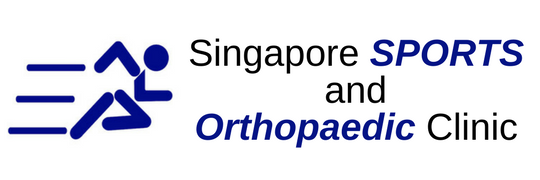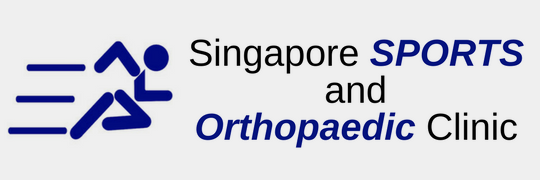Physiotherapy (Orthopaedic Physical Therapy)
 In Singapore and much of the world, the terms physiotherapy and physical therapy are used interchangeably.
In Singapore and much of the world, the terms physiotherapy and physical therapy are used interchangeably.
This branch of physical therapy focuses on the problems from the musculoskeletal system (muscles, bones, ligaments or tendons) and is used in hospitals and specialist clinics. Physiotherapy in this area deals with diagnosing, managing and treating injuries and problems from the muscular and skeletal methods and rehabilitating right after orthopedic operations, as well.
In Singapore, orthopedic therapy workers function particularly in treating postoperative joints, acute injuries due to sporting activities, arthritis and amputations. Some forms of the techniques and approaches involved in orthopedic physical therapy to make recovery faster are strength training, hot/cold packs, joint mobilizations and electrical stimulation. An additional procedure recently utilized is the sonogram, particularly in remedies like muscle retraining.
Orthopedic physical therapy is essential to restore the patient’s’ activity, strength and motion right after injuries or surgery. Its importance is two folded. On the 1 hand, orthopedic patients typically have deficiencies and weaknesses which could be eliminated or at least alleviated via particular targeted workouts and only a specialized physical therapist can show the patient and teach him/her the appropriate workouts designed to restore and enhance functions or, at least minimize the problems.
Below are essential things therapists can do in orthopedic physical therapy and there are lots of rehabilitation tools that they have on hand. Among these we ought to mention: stretching, strengthening (closed chain, proprioceptive, etc), ice and heat therapy, ultrasound, etc. Stretching is critical if a patient has stiff joint, which can affect normal activities severely. Proper stretching exercise can assist preserve such functions. To aid a patient in improving the function of his/her muscles, increasing endurance and maintaining or improving the range of motions strengthening workouts are utilized. Closed chain workouts are meant to assist balance the strength of muscles whereas proprioceptive workouts assist patients who lost the sense of knowing where a body part is in space due to a sprain for example, learn again how to control the position from the respective injured joint.
The ice and heat therapy warm up and cool off muscles and contribute to the stimulation of blood circulation and assist decrease swellings, as well. By utilizing an ultrasound probe, deep tissues are stimulated and warmed while the blood flow will improve. Even though you can find numerous orthopedic problems that could be solved without physiotherapy, yet quite frequently really easy workouts might assist expedite the healing procedure, not to mention the complicated situations in which a physical therapist particularly trained for, is really a must.
Orthopedic Physiotherapy Rehabilitation
Orthopedic Rehabilitation or physiotherapy can help with many different problems including:
- Pre and Post Surgical Care of all Orthopedic Conditions
- Balance/Vertigo Rehabilitation
- Postural Training
- Arthritis Management
- Back/Neck Rehabilitation
- Joint Pain Management
- Headache Management
- Manual Therapy/McKenzie Treatment
- Spinal Stabilization
- Muscle and Ligament Strains and Sprains
- Myofascial Release
- Auto Accident Injuries
- Work Injuries
The length and severity of the treatment varies greatly based on many factors. For more information, make your first appointment today!
Basic Orthopedic Physical Therapy Assessment
The need and assessment on what type of therapy to perform is based on the following factors:
- Patient history
- Observation
- Examination of movement
- Special tests
- Reflexes and cutaneous distribution
- Joint play movements
- Palpation
- Diagnostic imaging
When is Physiotherapy Treatment needed?
While it is always more advisable for a certified physician to decide your needs, you should still set an appointment if you experience any of these symptoms:
Loss of balance and coordination
This may occur dues to a variety of reasons like vertigo but if this is a problem for you, physiotherapy can retrain your body to maintain balance during daily activities.
Stubborn Pain
Back or neck pains don’t usually last a long time, but they do happen on and off which may discourage some people from seeking help as they think everything will be fine. However, there are severe risks of further injury should the condition remain untreated.
Recurring Injuries
If you keep suffering from pain in the same area or have an old injury that just won’t heal, seek help. Addressing the pain not only helps you with feeling better but prevents more serious issues from cropping up.
Disturbed Sleep
This is a common symptom of patients with lower back pain which can keep them awake at night and prevent good rest.
Neurological Issues
Especially for victims of stroke, physiotherapy is greatly useful for developing training techniques to maintain mobility. Often when the brain or nerves systems are compromised, patients will have to retrain themselves to walk.
If you suffer from any of these symptoms do not hesitate to make an appointment. As the old adage goes, prevention is better than cure! Take the rights steps now to avoid greater physical danger!
Duration of Physiotherapy
How long will physiotherapy take is a common question asked by many people. Although the question itself is a simple one, the answer is much more difficult. Because each and every person is different, and many factors may play into determining your overall prognosis and length of physiotherapy. So how long does it take?
Unfortunately, there is no correct answer to this question. Each person is different, and thus an individual’s rate of healing is also different. It may take one person only three days to walk a hundred feet after knee surgery, however, a patient who had surgery on the same day may need five days to reach the same distance. This is due to the variation in pain perception, motivation, and healing rate each of us has.
Rather than setting a date to complete therapy by, set various goals that you would like to achieve during your rehabilitation program. Make this your focus, not time. Reward yourself for achieving these goals, regardless of the time taken to reach them. Your physical therapist can help you set these therapy goals and can help keep you on track.
3 Things to Expect During a Physical Therapy Visit
It’s not surprising that you are a headless chicken with regards to a physical therapy visit. No one wants to go for it if ever possible. If you are a greenhorn, you must definitely be curious about what you will be doing and prepare yourself for it. Firstly, you must know that a physical therapy visit non-surgical and there is no need to worry about needles and blood. The one and only aim of your physiotherapist is to bring you back on the road to recovery. So what are some things to expect during a physical therapy visit?
Initial Evaluation
The initial evaluation part of the session is the most important. It gives the therapist a full picture of your past lifestyle, your cause of injury and what you wish to achieve in the future. This way, your therapist can then design an efficient programme for you in the most suitable timeframe and physical level. If your goal is just to be able to walk properly after a knee surgery for example, he will simply prescribe you exercises to strengthen the core muscle groups to provide stability. However, if you intend to go back to competitive sports post surgery, the plan will be totally different. This part will also include your medical history which can affect your recovery progress.
Treatment
After a proper warming up session, you will start to perform exercises designed specifically for your condition. A post knee surgery patient will need to perform balancing as well as stability exercises to strengthen the surrounding muscles so that they can bear the weight better. Some common exercises would be the leg press and stairs. Stretches will also be performed with the intent of achieving a full range of motion at places such as the knee and elbow joint.
Review of Session
After a proper cooling down session, your physiotherapist will then sit down with you for a review of your physiotherapy session. Throughout the session, he is busy noting down the amount of weight you can bear, degree of motion as well as your flexibility. A good therapist will go through these figures with you so that you know whether you are improving or lagging behind. He will also inform you what to expect during the next session and prescribe you some exercises you can do in the comfort of your own home.
A physical therapy session is actually fun and enjoyable to the patients. Although it may be physically tiring at times, patients are given exercises which are manageable to them and they are able to review their progress at the end of each therapy.
6 Various Physiotherapy Methods
Physiotherapists are experts in their own fields, just like how a surgeon is in his. From strains to sprains and bruises to fractures, physiotherapists are able to restore the body back to optimum performance. In less serious injury cases, physiotherapists are able to help you recover without surgical intervention whereas for serious ones, they can help you to recover faster after surgery. Let’s look at some physiotherapy methods and techniques below.
Hands-on
Physiotherapists like to get their hands dirty, literally. Physiotherapists love to do things manually, such as hands-on approaches. Common examples include stretching, massaging and compressing. Manual therapy is the foundation of any treatment plan prescribed by physiotherapists and they believe it will help patients to recover faster and better.
Physiotherapy with Drugs
Sometimes, physiotherapy needs to be performed in conjunction with medical drugs. For injuries such as muscle strains, it appears to be more beneficial if the patient is prescribed muscle relaxant drugs and ointment together with interferential therapy which uses electrical signals that produces soft massaging effects to stimulate the body into producing endorphins for natural pain relief.
Physiotherapy with Surgery
For injuries that are much more serious, physiotherapy in combination with surgery offers the best results. Physiotherapy starts way before the surgery date as the patient will need to beef up his body and strengthen the various core muscle groups. Post-surgery physiotherapy will involve regaining back the full range of motion, preventing scarring tissues formation as well as regaining full post-injury fitness and condition.
Good ol’ Physiotherapy
In minor cases, physiotherapy alone is sufficient to help the patient recover. In cases such as ankle sprains, massaging the ankle under heat will help to warm up the muscles and tissues, increase blood flow and speed up recovery. Neither surgery nor medication is required in this case.
Ultrasound
Ultrasound which is effectively inaudible sound waves are able to penetrate beyond our subcutaneous tissue layer, loosening it to prepare for physical therapy. It supplies a mild touch of heat to expand and warm up the surrounding tissues, increasing blood flow and speeding up the healing rate.
Electrical stimulations
Electrical stimulations when applied in a small dosage and in a controlled manner can help to stimulate the muscles to contract. This is especially important in patients who are suffering from traumatic injuries which cause them to lose their muscular functions. By using electrical stimulations, proper movement and functions can be restored in a speedier way.
Above are 6 physiotherapy methods explained and explored. Physiotherapy is an integral treatment method that often works hand in hand with surgery. Although the actions done may seem simple, they are actually very effective towards restoring full bodily function.
Physiotherapy Treatment in Singapore
You can contact us for treatment regarding physiotherapy. Our specialists have more than 20 years of experience. Our location is pretty convenient to visit – Gleneagles Medical Centre in Central area of Singapore.






